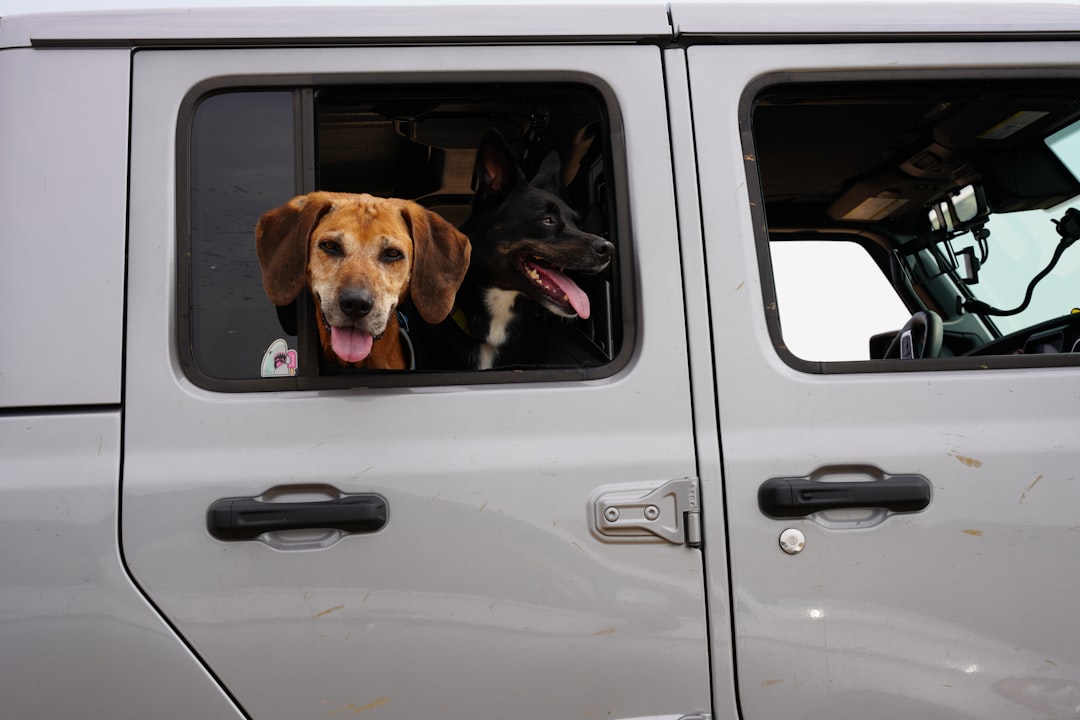

Engage prospects with a scan and streamline customer engagement with FREE QR code marketing tools by Sona – no strings attached!
Create a Free QR CodeFree consultation

No commitment

Engage prospects with a scan and streamline customer engagement with FREE QR code marketing tools by Sona – no strings attached!
Create a Free QR CodeFree consultation

No commitment
Pet transportation services face persistent challenges in delivering seamless, secure, and reassuring experiences for pet owners. Customers are not only anxious about their pets' safety and well-being, they are also frustrated by fragmented processes where vital information is trapped in paperwork, phone calls, or manual updates. Missing or incomplete digital records can lead to lost opportunities for engaging with high-value prospects or following up with interested customers who never fill out online forms.
Growth-focused pet transport companies are turning to solutions that simplify information capture, enable real-time tracking, and foster stronger trust. One of the most effective bridges between offline touchpoints, such as crates, check-in desks, and appointment cards, and digital engagement is the QR code. This technology delivers instant, accessible pathways for clients to access forms, travel documents, safety assurances, and live journey updates while allowing the business to track engagement.
Integrating QR codes along key customer touchpoints enables pet transport companies to close the gap between anonymous inquiries and qualified leads, provide transparent service updates, and mitigate the risk of communication breakdowns. The following guide explores how strategically deployed QR technology can reduce missed connections, improve conversion rates, and ultimately differentiate providers in a crowded, customer-driven market.

Too often in pet transportation, critical processes like sharing travel requirements, agreements, or real-time updates are bogged down by manual workflows and paper forms. This lack of digital continuity leaves service providers with no reliable mechanism to capture and nurture high-intent prospects and exposes teams to costly errors or missed follow-ups. The absence of a seamless offline-to-online transition also means potential leads remain anonymous, never making it into CRM or retargeting lists.
QR codes provide a clear path to fix these gaps. Replace printed brochures that quickly get outdated with a simple scan that opens the latest travel guidelines or vaccination requirements, as shown in this video tutorial. Convert paper contracts into digital consent and liability forms that pre-fill owner data, reduce double entry, and trigger automated workflows. Turn post-it notes and manual phone trees into real-time alerts and live tracking accessible from crate labels and appointment confirmations.
By linking these touchpoints, pet transport companies can automate follow-up, reduce the risk of losing interested customers who hesitate at form submissions, and surface valuable engagement signals along the customer journey. The result is a modern, connected experience that reduces operational friction while deepening trust through transparent communication.

The pet transportation sector is built on trust, transparency, and the need to respond quickly to both routine relocations and urgent requirements. Companies often struggle with manual data entry, poorly tracked offline interactions, and limited visibility into prospect activity, allowing many leads to slip through the cracks unseen and unpursued. Busy teams cannot afford to waste time chasing paperwork or deciphering incomplete customer notes when a pet’s travel deadline is approaching.
QR codes solve these problems by connecting physical processes with digital systems in an instant. A code placed on a crate, a check-in desk, a van door, or a discharge packet can guide owners to the exact resource they need, while simultaneously capturing intent signals and routing them into CRM, scheduling tools, or automation sequences. As regulations and routes change, dynamic QR codes ensure the content stays accurate without reprinting materials.
Pet transport companies encounter challenges keeping customers informed and engaged at every stage, often due to disconnected documentation, difficult contact management, and a lack of automated follow-up. Different QR code formats offer targeted solutions, and selecting the right one ensures a smooth customer experience and high operational efficiency.
For most providers, dynamic QR codes are the best default because they allow real-time updates, scan tracking, and flexible routing. Static codes have their place for evergreen content and low-risk contexts. The formats below cover the majority of needs in pet transportation.
Dynamic QR formats ensure codes can adapt to evolving regulations, travel routes, and service tiers, reducing brand risk and simplifying compliance. With Sona QR, you can generate any of these formats, switch destinations without reprinting, and manage them in one place.

Many pet transport businesses miss out on high-value leads because their physical assets, such as posters, crates, and vans, do not enable digital follow-up or intent tracking. Growth opportunities emerge when every customer touchpoint becomes a lead capture and engagement channel. This transformation increases attribution clarity and reveals where to invest for the next wave of demand.
Prioritize placements that match natural customer behavior. Owners spend time at veterinary clinics, pet stores, breeder facilities, and airports, and they notice branded vehicles in their neighborhoods. Codes placed in these environments can spark action at the exact moment of intent, while unique codes per location provide granular data for optimization.
Aligning code placements with the natural flow of a customer’s journey turns previously invisible interactions into actionable growth opportunities while addressing the risk of disengaged or anonymous prospects. Over time, the scan data will show which channels deserve more budget and which messages prompt the strongest responses.

Throughout the booking-to-delivery cycle, companies wrestle with delayed check-ins, lost forms, and unconverted quote requests. QR-enabled workflows integrate with each step to reduce friction for owners and staff, and to ensure that every interest signal is captured for follow-up. These use cases map to daily operations and can be rolled out gradually to maximize adoption.
Start with the moments that generate the most questions or slowdowns. Then expand to value-added touchpoints that build loyalty, such as post-trip care instructions or referral programs. The three use cases below are the most common starting points for pet transport providers.
These applications ensure high booking interest turns into measurable conversions and that anxious moments become opportunities to build trust. As adoption grows, you can add codes for emergency protocols, payment plans, and loyalty rewards to deepen engagement after the first trip.
A persistent pain point in pet transport is that high-intent prospects researching services or picking up brochures remain unknown and unpursued. QR-enabled campaigns solve this by treating every scan as a powerful intent and segmentation signal. With the right strategy, each scan can indicate where a customer is in their decision process and what topics they care about most. See Sona’s intent data.
Segmentation can then power tailored messaging that meaningfully improves conversion. Prospects scanning general service flyers need education about safety and compliance, while those scanning pricing sheets or crate labels are closer to purchase and may need incentives or scheduling options. Owners who scan tracking codes during transit need reassurance and timely updates, not sales pitches.
With Sona QR, each code becomes a smart entry point into your funnel, capturing behavior-rich data that powers retargeting without guesswork. Over time, your audience strategy evolves from broad blasts to precisely targeted sequences that reflect real-world behavior.
Fragmented marketing campaigns often result in inconsistent messaging and wasted spend, as prospects get lost between physical and digital channels. In pet transportation, you likely use a mix of clinic partnerships, direct mailers, local events, and branded vehicles. QR codes provide the connective tissue for unified, measurable multi-channel efforts that move owners from awareness to action. For measurement strategy, see Sona’s offline attribution.
The key is to treat QR codes not as one-off links, but as orchestrated triggers within a broader marketing engine. Each placement should have a clear call to action, a matching landing experience, and a defined next step. Centralized platforms such as Sona QR make it easy to manage, test, and analyze all of these codes in one place.
QR codes serve as the offline onramp to your digital marketing engine. They also unlock a new layer of data collection across channels that were once difficult to measure. With a centralized platform like Sona QR, you can manage all your codes, monitor performance, and sync scan data with your CRM and ad platforms to keep every channel aligned.
Many providers find QR initiatives stall due to unclear goals, poor code design, or scattered deployment. A strong plan, clear metrics, and disciplined execution transform QR codes from a novelty into a reliable revenue driver. Treat your first rollout as a pilot, then scale what works across regions, partner clinics, and service lines.
Below is a practical execution plan for pet transportation services. Use it to align teams, reduce missteps, and build momentum toward a fully connected customer journey. Each step includes guidance on tools, creative choices, and operational oversight so you can launch with confidence.
Clarify the business outcome you want to influence. Do you need more quote requests, faster document submission, higher show-up rates, or better post-trip reviews? Pick one objective for the first campaign to keep tracking clean and results interpretable.
Select the QR format that matches your goal and the level of flexibility you need. In most cases, dynamic codes will be the right choice because they allow content updates and scan tracking without reprinting.
Strong design improves scan rates. Make your code on-brand and easy to understand at a glance. Support it with a clear promise of value, not just a generic instruction to scan.
Coordinate placements across the real-world touchpoints your customers already use. Unique codes per location or asset will help you attribute results in detail.
Measurement closes the loop. Monitor scans, conversions, and drop-off points to guide iterative improvements. Share results with staff and partners to keep adoption high.
By treating this as a continuous process, companies uncover ongoing improvement opportunities and reduce wasted spend. The more you measure and refine, the more predictable and scalable your QR-driven growth becomes.

A recurring challenge is tying physical engagement back to pipeline growth or customer lifetime value. Too often, offline actions like scanning a crate tag or event banner are not connected to downstream outcomes. Analytics-driven QR programs fix this gap by linking scans to bookings, payments, and reviews, then displaying the full path from first interest to revenue.
Success requires consistent data capture and clean integration. If your team can see which posters, vans, or crates sparked the most valuable actions, you can allocate budget with confidence and refine your operations for reliability. Benchmarks to monitor include scan volume by placement, conversion rate from scan to form completion, and review rates triggered by post-trip codes.
With Sona QR and Sona.com, you can track every scan, measure engagement by channel and context, respond in real time, and sync with your CRM to attribute revenue accurately. Identity resolution and multi-touch attribution connect anonymous scans to known buyers, unifying fragmented touchpoints across buying stages into one performance view.
Even well-intentioned QR campaigns can underperform if they are not aligned with operational realities. Owners need clear reasons to scan, staff need consistent talking points, and codes need to be measurable. The tips below focus on high-impact tactics that fit the pet transportation environment.
Start with the media you already use, such as clinic handouts, invoices, crate labels, and van wraps. Then add automation that turns scans into meaningful next steps. This approach minimizes change management while maximizing impact across booking, tracking, and reviews.
Creative idea: Include a “welcome home” QR kit with a scannable card that prompts a review, offers a discount on a future trip, or invites referrals at the happiest moment. Another idea: A QR code on a branded kennel mat at partner clinics that loads a short video on preparing pets for travel, paired with an option to request a quote.
QR codes are rapidly redefining how pet transportation providers interact with pet owners. By transforming offline touchpoints into actionable digital gateways, these companies solve persistent pain points, build trust through transparent, measurable engagement, and position themselves for success in a customer-driven industry. The right placements, compelling calls to action, and strong analytics can turn every crate, invoice, and poster into a growth channel.
Implementing QR codes in pet transportation eliminates barriers between offline actions and digital engagement, helping companies capture, nurture, and convert both known and previously anonymous leads. By addressing workflow inefficiencies, surfacing hidden engagement signals, and enabling consistent, data-backed messaging, QR technology not only enhances service transparency and compliance, it also drives measurable growth and loyalty. With Sona QR, you can generate your first codes in minutes, manage campaigns at scale, and connect scans to revenue in Sona.com so QR becomes a reliable part of your performance strategy. Start creating QR codes for free.
QR codes have transformed pet transportation services from simple logistics into seamless, data-driven experiences. Whether it’s streamlining pet check-ins, enhancing communication between pet owners and transport teams, or providing instant access to critical travel information, QR codes replace cumbersome paperwork with fast, mobile-friendly solutions that boost efficiency and trust. Imagine knowing exactly when and where a pet’s journey is updated, giving both providers and owners peace of mind every step of the way.
With Sona QR, you can create dynamic, trackable QR codes in seconds, update travel details instantly without reprinting, and connect every scan to improved operational workflows and customer satisfaction. No more lost information or delayed updates—just smarter, more transparent pet transportation services that keep pets safe and owners confident.
Start for free with Sona QR today and turn every scan into a smoother, safer journey for pets and their people.
Choose a pet transportation service that uses transparent communication, real-time tracking, and digital workflows like QR codes to ensure safety, compliance, and seamless customer engagement.
Costs vary, but pet transportation services reduce operational friction and improve efficiency by using digital tools such as QR codes, which are inexpensive to generate and deploy across service touchpoints.
Pet owners can access up-to-date travel guidelines, health certificate requirements, and checklists through QR codes provided by the transport service, ensuring pets meet all necessary compliance before travel.
Services use digital manifests, airline-specific requirements, vet clearances, and live tracking via QR codes on crates to ensure pets' safety and compliance with regulations during transportation.
Live tracking is enabled through dynamic QR codes placed on travel crates and appointment confirmations, providing real-time status updates and wellness checks accessible by pet owners.
QR codes connect offline touchpoints with digital systems to provide instant access to forms, travel documents, live updates, and enable service providers to track engagement and automate follow-ups.
They embed QR codes in printed materials, crates, appointment cards, and vehicles to offer instant booking, document uploads, live tracking, and post-journey surveys, reducing manual processes and increasing trust.
Dynamic QR codes are preferred for real-time updates and tracking, while static codes serve evergreen content; formats include web links, vCards, SMS or email templates, Wi-Fi access, document downloads, and app links.
Effective placements include veterinary clinics, pet stores, breeder facilities, airports, travel crates, direct mail, invoices, and branded vehicles to reach customers at natural points of intent.
Each scan acts as an intent signal, enabling segmentation by journey stage, pet type, location, and timing, which feeds CRM and ad platforms for personalized follow-up and improved conversion.
They should define clear goals, choose appropriate QR code types, design and test codes with branding and accessibility, deploy across key channels with contextual calls to action, and continuously track and optimize performance.
Success is measured by tracking scan volume, conversion rates from scans to form completions or payments, attribution by channel and location, and linking scans to revenue and customer lifetime value through CRM integration.
Use unique codes per asset and location, add UTM parameters for accurate attribution, trigger automated follow-ups after scans, and train staff to explain QR code benefits clearly to pet owners.
Use Sona QR's trackable codes to improve customer acquisition and engagement today.
Create Your FREE Trackable QR Code in SecondsJoin results-focused teams combining Sona Platform automation with advanced Google Ads strategies to scale lead generation

Connect your existing CRM

Free Account Enrichment

No setup fees
No commitment required

Free consultation

Get a custom Google Ads roadmap for your business






Launch campaigns that generate qualified leads in 30 days or less.
